October 2008: The Clark Museum
Williamstown, MA, USA
My first visit to the Sterling and Francine Clark Art Institute in Williamstown, MA was during the run of the exhibition “Like Breath on Glass: Whistler, Inness, and the Art of Painting Softly”, which ran from June through October of 2008 and featured a quietly magnificent collection of subtle, dreamlike, tonalist paintings – portraits, landscapes and interiors – that was as arresting to me as the astounding main collection. I have returned to the Clark regularly in the years since, but this exhibition remains a special memory for me. I wish I could step back in time and visit it again.
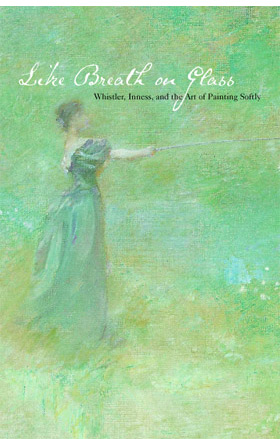
This was also my first real introduction, as an aspiring artist, to the works of James McNeill Whistler, John Henry Twachtman, and Thomas Wilmer Dewing, among others. Everybody’s seen “Whistler’s Mother,” of course, but that was the extent of my mental catalog of his work. This show began the long correction of that shortcoming, and provided the seed of interest in other artists I would continually seek out in the years to follow.
Nascent in my thinking was this aphorism (misattributed to Bansky but more properly traced originally to journalist Finley Peter Dunne):
Art should disturb the comfortable and comfort the disturbed.
This has been lodged firmly in my mind ever since, and the Like Breath on Glass exhibition was firmly anchored in the latter category, which is mainly where I aspire to be also. In an America that already felt hyperactive and bitterly divided in late 2008 – oh, we had no idea what was to come – it was a refuge of hushed sanity.
Works and notes
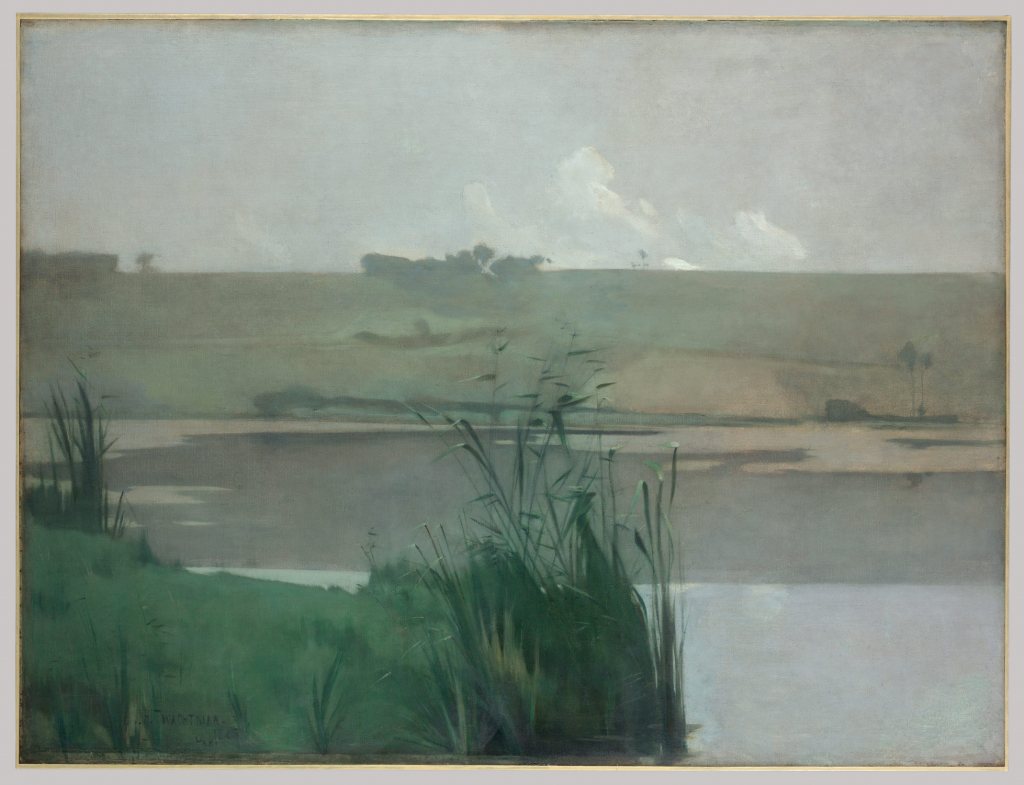
Image courtesy of the Metropolitan Museum of Art
John Henry Twachtman, Arques-la-Baille (1885)
The hill across the water and the sky initially drew me to this one; the reeds in the foreground almost feel too dark to me, but that increases the appeal of the distant elements of the scene and creates a kind of tension that’s interesting, while not unpleasant. One of the golden rules of landscape scenes is to invite the viewer into the picture through compositional choices, and this scene makes me want to climb the hill through the heavy air and see what’s on the other side. The low clouds suggest a low horizon, indicating that the scene is up high and there would be a fine vista.
However, it’s the overall stillness of the scene that I find most appealing, naturally. Like most of the works in this exhibition, the colors are very muted (more properly: low in chroma), which produces a calming effect that I love in landscapes. The water is still as glass and the reeds stand straight, suggesting no wind, no sound, nothing that commands our attention; just a warm, hazy day in a quiet place.
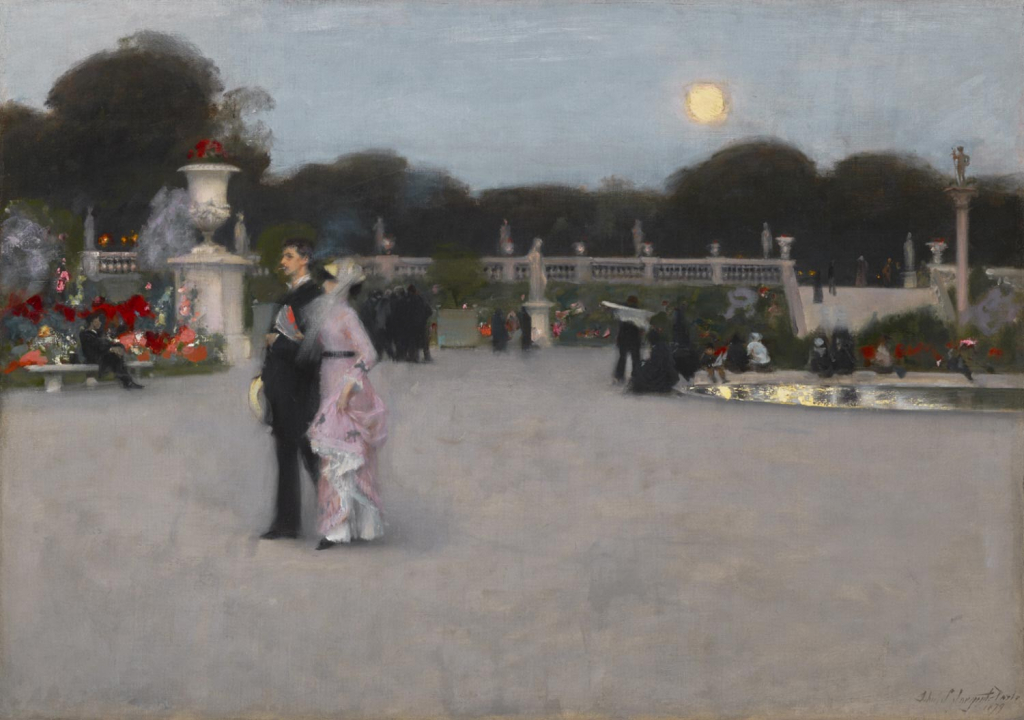
Image courtesy of the Philadelphia Museum of Art
John Singer Sargent, In the Luxembourg Gardens (1879)
Plenty of atmosphere in this one to admire, one of Sargent’s most famous paintings. However, this one paralyzed me for a while, mostly for just this aspect: the way he painted the roses on the left with what appears at a distance to be a single stroke, and even with close inspection, doesn’t appear to be much more than that:
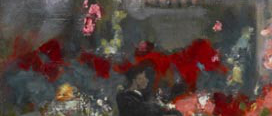
Sargent is justifiably revered for many reasons; I’m far from alone in considering him one of the last true masters of painting. Henry James wrote that even Sargent’s early work showed “the slightly uncanny spectacle of a talent which on the very threshold of its career has nothing more to learn.”
One of the aspects of Sargent’s work that is so masterly, and so intimidating to painters studying him, is that it appears to be done with so little effort. I remember gazing at these roses for a long time, feeling hopeless about the unimaginable bravura on display, and wondering if I would ever develop such confidence myself. Later, in discussions of this work with much more experienced painters, I was assured that what I did not see here were the twenty previous attempts that were tried and wiped out in an effort to make it look effortless. That’s no doubt truer than I believed, though obviously his confidence was warranted. Still, it was an early moment of awareness that attitude, both authentic and carefully manufactured, are aspects of painting that are not unimportant.
Only after years of the contemplation of nature can the process of selection become so sure an instinct; and a handling so spontaneous and so freed from the commonplaces of expression is final mastery, the result of long artistic training.
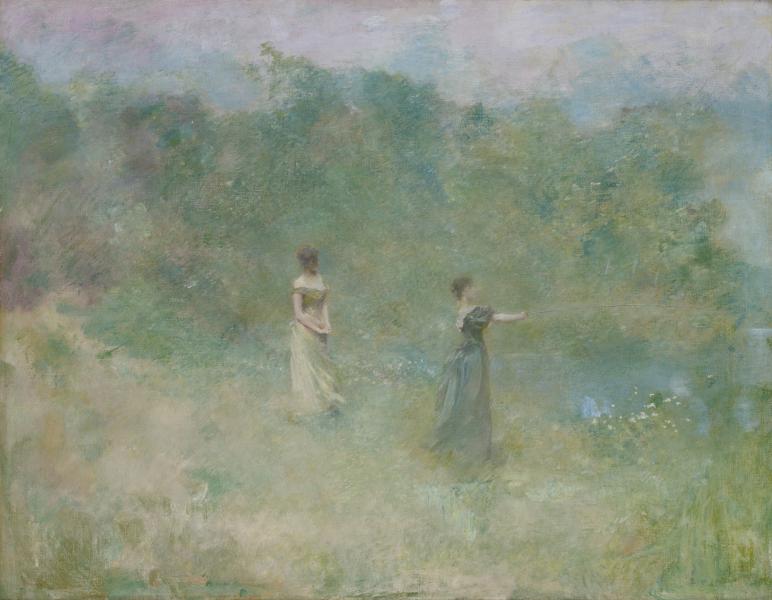
Image courtesy of the Smithsonian American Art Museum
Thomas Wilmer Dewing, Summer (ca. 1890)
Dewing!
This lush image was used (and recolored) for the show’s literature, signs and brochures, and justifiably so. I’m not sure Dewing had a lot left to learn either. I’ve only seen a handful of his paintings, but they’re all among my favorites. He tended to favor elegant women in quiet situations, painted through a haze with backgrounds abstracted down as far as practical and wonderfully soft edges on everything, leaving plenty of room for the viewer to participate in the mental completion of the picture. I can’t find anything to critique in this. Every one of his paintings shows a hushed, tranquil moment of quiet contemplation and simple living. They make me feel peaceful. They accomplish everything they set out to do.